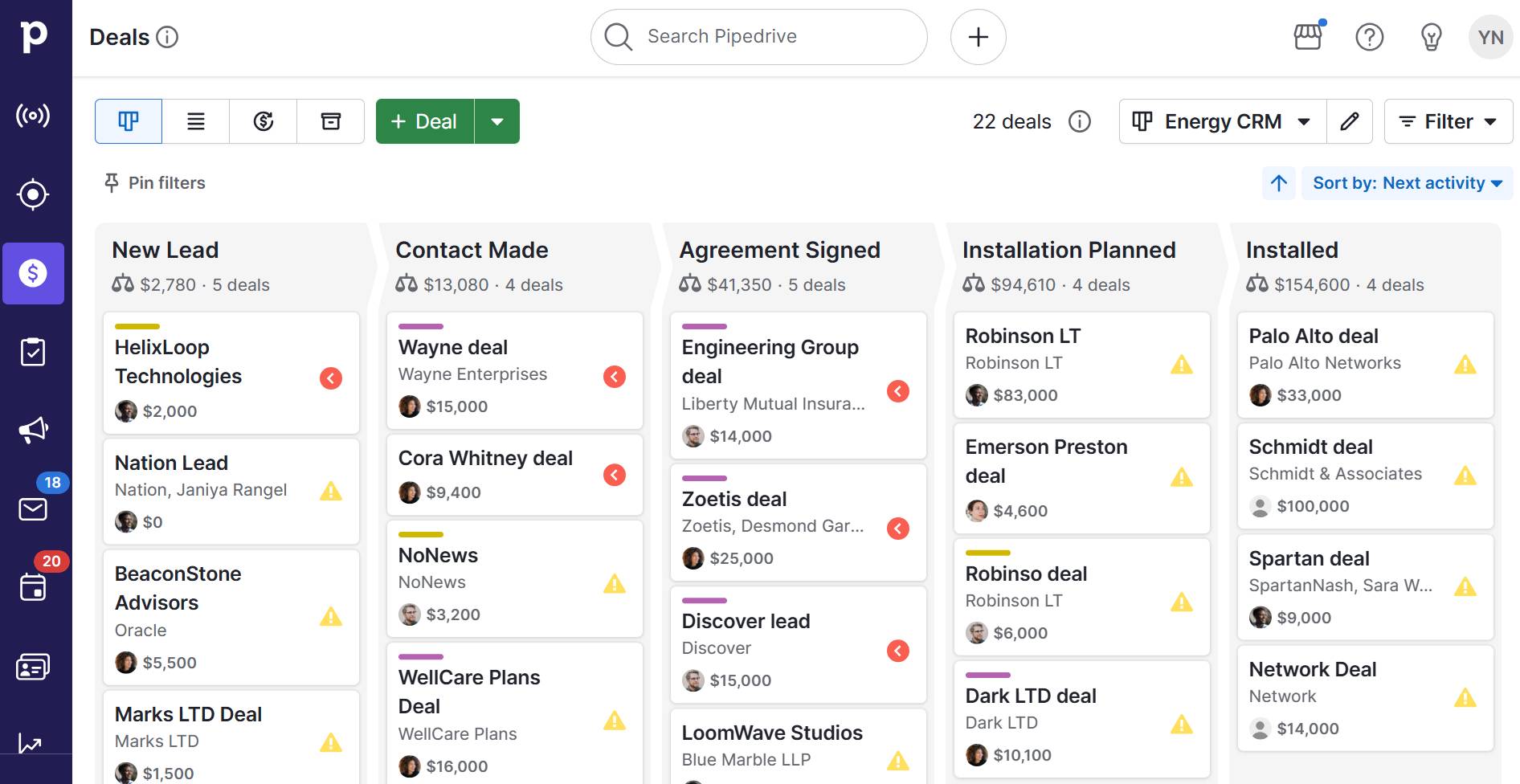Without the convenience of in-office collaboration, remote team management requires managers to be strategic about systems and intentional about communication.
Luckily, there are many tools and strategies to help remote workers successfully exchange ideas while staying organized and productive.
In this article, we share tools for managing remote teams, best practices and examples of how to create a supportive and productive remote work environment that fosters accountability and team growth.
Key takeaways from How to Manage Remote Teams
Remote team management – leading and supporting distributed teams – requires unique skills and tools.
The right software works together with your existing processes to simplify collaboration and task management for team members working asynchronously.
Strong onboarding, clear visibility and ongoing training make remote work run smoothly, while the right skill sets helps remote managers communicate well, stay organized and lead with empathy.
Pipedrive keeps teams running smoothly by streamlining workflows in everything from deal progress to project management to email marketing – try it free for 14 days.
Top remote team management software in 2026
To learn how to manage remote teams effectively, it’s critical to find the right tools for communication, collaboration and project management.
Overly complicated technology can lead to more problems than solutions and isolate your less tech-savvy team members, so watch out for tools that over-promise but under-deliver on ease of use.
It’s also easy to over-rely on tools and end up with too many in your stack that can’t communicate.
If you’re already operating remotely and looking to overhaul your apps, start by surveying your staff to see which tools cause the most trouble and which are crucial for operations.
Once you have the right systems in place, work will be efficient and remote team members will feel supported and connected to the team.
Here are a few of the best tools to add to your remote work tech stack.
1. Best all-in-one tool: Pipedrive
Pipedrive is a sales-focused customer relationship management (CRM) tool with additional email marketing, customer service, documentation and sales lead generation functions.

The Pipedrive CRM improves sales workflows, increases productivity and helps teams scale by housing everything customer-related in one organized place.
For example, say you’re a remote sales team manager for the Duolingo app and your goal is to expand its use into corporate settings.
You can use Pipedrive to assign tasks to sales team members or use an integrated app to manage your workload. You’ll be able to see which deals are in progress, identify any bottlenecks and jump on any stalled deals yourself.
Pipedrive’s analytics dashboard lets you see if your team is on track to meet its quarterly goals.
The detailed reporting functions help take the guesswork out of decision-making.
Pipedrive’s top features let your remote team:
Collaborate easily on deals through a visual sales pipeline
Centralize document management, from tracking contracts and proposals to requesting e-signatures with Smart Docs
Send calendar and meeting invites to prospects to eliminate back-and-forth or double-booking through Pipedrive’s scheduling tool
Create forms, chat with web visitors or search for prospects using Leadbooster, Pipedrive’s lead generation software add-on
Design customizable email marketing campaigns through Campaigns by Pipedrive, an email marketing software add-on
Monitor who visits your website with Pipedrive’s web visitor add-on
You can use Pipedrive to assign tasks to sales team members or use an integrated app to manage your workload. You’ll be able to see which deals are in progress, identify any bottlenecks and jump on any stalled deals yourself.
Pipedrive’s analytics dashboard lets you see if your team is on track to meeting its quarterly goals. The detailed reporting functions help take the guesswork out of decision-making.
Why we like Pipedrive for remote team management: Pipedrive is a cloud-based solution, making it perfect for remote work. Its wide range of features, add-ons and integrations means you can be confident your team members have all the tools they need to perform their roles well without micromanaging.
2. Best file-sharing tool: Google Drive
Google Drive is a cloud-based storage service that allows teams to easily collaborate on documents, spreadsheets and slides via files that sync automatically across devices.

Google Drive makes it convenient for teams to work together on documents or presentations in real-time, eliminating multiple versions and sending documents back and forth.
Teams can organize files across drive folders with newly enhanced file searching filters that help team members locate files even quicker.
Managers can create templates, keep track of document changes and leave comments for easier collaboration.
Google Docs, Sheets and Slides are also shareable with users outside a team’s direct organization for faster collaboration with vendors or clients.
Google Drive integrates with other tools to minimize dashboards and disruption, like the Google Drive integration by Pipedrive.
Why we like Google Drive for remote team management: Google Drive is an easy way for remote staff to share files with managers. The Google Drive comment function allows managers to leave notes directly on the document and to tag the team member responsible for making changes.
3. Best tool for team meetings: Zoom
Zoom is a video conferencing tool remote managers use to meet with virtual teams.

Zoom video calls are perfect for one-on-one, small-group or company-wide meetings. You can record the meetings for later viewing or share them with team members who missed the live call.
Zoom’s chat feature is helpful for large group sessions because it allows staff to ask questions without interrupting the speaker’s flow.
Zoom joined the generative AI (GAI) movement with its AI Companion – available to all paid subscribers. The AI Companion offers text-based support features like meeting transcription and summarization that improve note-taking and help people catch up on missed information.
Zoom also integrates with other tools to streamline efficiency, like the Zoom Meetings by Pipedrive integration.
Why we like Zoom for remote team management: Remote managers can use screen sharing to collaborate on projects or provide training that’s just as effective as in-person training. Zoom also has a new whiteboard feature that offers another way to brainstorm ideas during calls.
4. Best team communication tool: Slack
Slack is a team messaging tool that makes email look like snail mail, and its new interface aims to make team communication even more efficient.

Team members can send messages back and forth on Slack in real-time or asynchronously. Slack direct messages can be one-on-one between coworkers or a group message to all members involved in a project.
Managers can designate Slack channels for group messaging on specific topics, such as “announcements” and “quarterly planning”.
Team leaders can also track and reference specific channels and conversations to monitor workflows.
The “Slack canvas” feature provides another way for remote colleagues to work together. Teams can log meeting notes, list action items and share resources in a dedicated evergreen space.
Slack isn’t just for immediate team members, though. External conversations can also take place on Slack, with the capability to invite vendors or clients to a shared Slack channel.
It also integrates with other tools to eliminate endless back-and-forth emails, like with the Pipedrive Dealbot for Slack.
Why we like Slack for remote team management: Slack is more than just an instant messenger for the workplace. Teams can hold “huddles” for quick audio-first communication through the Slack app, an alternative for when another video call isn’t necessary.
5. Best video messaging tool: Loom
Loom is a screen recording and messaging tool that allows managers to record and share screen camera and audio easily.

Loom is great for recording quick training videos or giving fast individual feedback.
For example, you could send a Loom to deliver constructive criticism when a staff member submits a draft for review. Sending a Loom in response humanizes your message and can soften what may sound too harsh through text.
Loom also makes it easy to share announcements with your entire team, which allows for more nuance than an email alone can provide. Viewers can show their support or ask questions in response to the broadcast by leaving comments or reactions.
The Loom AI feature supports creating better videos with text summaries and new ways to edit and enhance videos.
Remote managers should keep an eye open for fresher updates, such as the ability to merge multiple Looms and find videos based on their transcripts.
Why we like Loom for remote team management: Loom is a great way to grow remote company culture without holding a live meeting each time there’s news to share, a topic to teach or a new process to explain. It allows for greater team connections as viewers can leave comments in response to videos.
6. Best project management tool: Trello
Trello is a project management software that allows remote managers to set up boards, create lists, use cards to create workflows and assign tasks to team members.

Trello helps team leaders manage projects by visually laying them out so all team members can see them and meet deadlines.
Managers can then monitor projects in a board, timeline or calendar format. Premade templates such as “New Hire Onboarding” and “Distributed Team Brainstorming” make Trello even easier for remote team management.
Trello’s AI Butler offers no-code automation that lets you easily set up actions by creating rules, buttons and commands.
Trello Power-Ups provide even more functionality by bringing other apps and additional features. For example, the Planyway Power-Up supports building a visual timeline to help managers track and manage teamwork across different projects.
Why we like Trello for remote team management: Trello is a top “lightweight” project management tool, offering a free plan for budget-friendly project management. Trello also integrates well with other tools, like the Pipedrive-Trello integration.
Tips and strategies for managing remote employees
Remote team management strategies are similar to in-office leadership methods, but many require different execution methods.
Consider these tips for onboarding, workload management and ongoing team training that support building an engaged and successful remote team.
Improve onboarding for remote employees
The remote onboarding experience is important for developing remote team cohesion and helping new employees feel connected despite the distance.
According to research from Insight Global, 80% of employees say they’d stay in a role longer if they had better onboarding.
Car insurance company Clearcover helps develop a sense of team for remote workers from the start.

The Clearcover team shared with Comparably that they follow a specific onboarding process to ensure all team members feel welcome and supported. It looks like this:
Human resources sends a welcome video, Clearcover swag and self-paced setup videos to enable new hires to configure their new computers at their own pace before they start
New employees meet virtually with IT to verify their computers are set up correctly and to fix any issues
Clearcover’s management holds a company overview session to demonstrate core values and operating principles
New hires attend a benefits session to review plans and get enrolled
Senior executives invite new hires to a quarterly virtual coffee and icebreaker session
Clearcover’s onboarding process gets new hires acquainted with each other, leadership and executives, which sends a strong message of positive team culture and connection from the start.
Additional onboarding tips
Set clear expectations | Clarify working hours, communication norms and response times so new hires know what’s expected from day one. |
Provide reference guides | Share procedures, templates and how-to documents to help new employees find answers without feeling stuck. |
Offer role-specific training | Walk new hires through their responsibilities, tools and workflows to set them up for success. |
Include remote-specific training | Teach remote work basics like healthy communication habits, time management and best practices for async collaboration. |
Reinforce work-life balance | Explain the importance of setting limits, as burnout due to overworking is easy when home and office blend together. |
Create visibility around workload and progress
Because remote employees work independently, managers need to make an active effort to understand how work is unfolding and where support is needed.
Along with using tools for collaboration and project management, it’s important to hold one-on-ones to check in with your staff, ask for their input and provide feedback.
Catching up with team members is not about micromanagement but about building trust between managers and their subordinates through supportive management practices.
Group projects and virtual coworking sessions also build employee engagement and prevent employees from feeling siloed or isolated in the remote environment.
Recruiting company DotConnect does this well across its globally distributed remote workforce.
According to reports on Comparably, DotConnect’s CEO and leadership team host weekly office hours where employees can drop in for coaching, support or brainstorming.
The leadership team also holds monthly “all hands” meetings to share business updates and milestones, recognize employees and follow through on their commitment to conscious leadership principles.
Additionally, DotConnect’s dedicated “culture connect” team plans various activities for team social interactions that encourage employee engagement.
Make ongoing training part of the job
Remote employees can’t rely on in-person coaching, so they need accessible ways to learn new skills and grow in their roles.
For example, enterprise experience platform Medallia Experience Cloud holds “Feel Good Fridays”, where employees are encouraged to leave their Friday schedules light on meetings to carve out time to focus on professional development.
This simple practice helps employees prioritize growth without feeling pulled away from their regular responsibilities.
Ongoing training in the remote setting may be direct training from a manager or using resources like LinkedIn Learning, books, webinars or industry-relevant courses.
The skills and qualities of great remote team managers
Remote managers need a mix of practical skills and personal qualities to support their teams from a distance.
Understanding these qualities can help you hire better, develop stronger leaders and create a healthier working culture overall.
Here’s what to look for when hiring a remote team manager.
Effective communication
Remote teams depend on clear communication because so much of the context you’d get in person disappears online.
While text-based communication through emails, comments and instant messaging is popular in remote setups, it’s easy to misinterpret in the absence of tone and body language.
As such, remote managers must pay attention to how they deliver sensitive messages to their staff. Text works well for tactical or task-related updates, but a video call is often better for more nuanced messages where tone matters.
Openness
Transparency and open communication with direct reports support deeper workplace relationships and build understanding.
Asking staff early on about their preferred learning and management styles is one way to facilitate open dialogue. It’s equally important to be transparent about communication preferences and management style.
Trustworthiness
Your team must be able to trust you if you want them to value your leadership. Remote managers can build trust by giving their staff feedback, showing them they value their contributions and being respectful and gracious for their work.
Empathetic
Because remote work can feel isolating, the best remote managers lead and communicate with empathy to help employees feel connected and cared for.
One way managers can show staff empathy is to proactively ask them how they’re doing and how the manager can support their well-being and mental health in the workplace.
Managers can establish an “open door” for any issues and use reassuring language that shows they hear their staff’s concerns, that they care and that they’ll help employees find a solution.
Download your guide to managing teams and scaling sales
Flexibility
Flexibility in remote management is essential as it’s one of the primary reasons people choose remote work.
Remote managers can embrace flexible working hours to help everyone, from caregivers to those with health needs, bring their best selves to work.
Inclusiveness
Cultural awareness and inclusivity are essential for all teams, but even more so for distributed teams where workers can span different countries.
Remote managers can practice cultural awareness and inclusion by respecting other cultures’ holidays and understanding differences in cultural etiquette.
Note: Diverse and inclusive business practices aren’t just good for positive team culture, they’re also good for business. According to Gartner research, diverse and inclusive teams see a 12% increase in performance.
Goal-oriented
Strong remote managers keep everyone aligned on what matters most, moving metrics in the right direction even when the team works from home.
When you’re operating away from the office, you’ll need to learn innovative ways to motivate the team toward business goals.
For example, managers could use gamification apps like Gamifier to create challenges. Employees don’t need to be in one place to watch their progress; it all happens remotely.
In addition to business goals, remote team managers should consider their team members’ individual goals. For example, if one team member indicates they’d like to be a manager, their manager could create a roadmap toward their goals and gradually give them more responsibilities.
Organized
Remote teams need organized managers because it’s easy for details to get lost when everyone is working from different places.
A remote team manager may be overseeing staff in multiple time zones with different working habits and various needs. They’ll need a good organizational system to keep on top of projects, especially when they can’t hop across the hall to check in.
Technology can help keep remote managers on track. Learn more about Pipedrive’s team CRM.
Pipedrive in action: Many companies use Pipedrive to simplify complex workflows and keep distributed teams aligned. Reintech, a UK–Ukraine recruitment company, used Pipedrive to streamline its entire hiring pipeline.
With only four team members, Reintech automated tasks, updates and candidate stages, allowing them to interview and evaluate 1,500 software engineers in one year without the usual manual workload or confusion.
Final thoughts
The soft skills that remote team management requires are similar to in-office management, but remote managers must be more intentional about communication and fostering team cohesion.
Even without face-to-face interaction at the water cooler, remote managers can build connections and encourage teamwork using the right tools and strategies.
Pipedrive makes managing a team remotely easier by supporting everything from lead generation to customer onboarding. Try it free.







